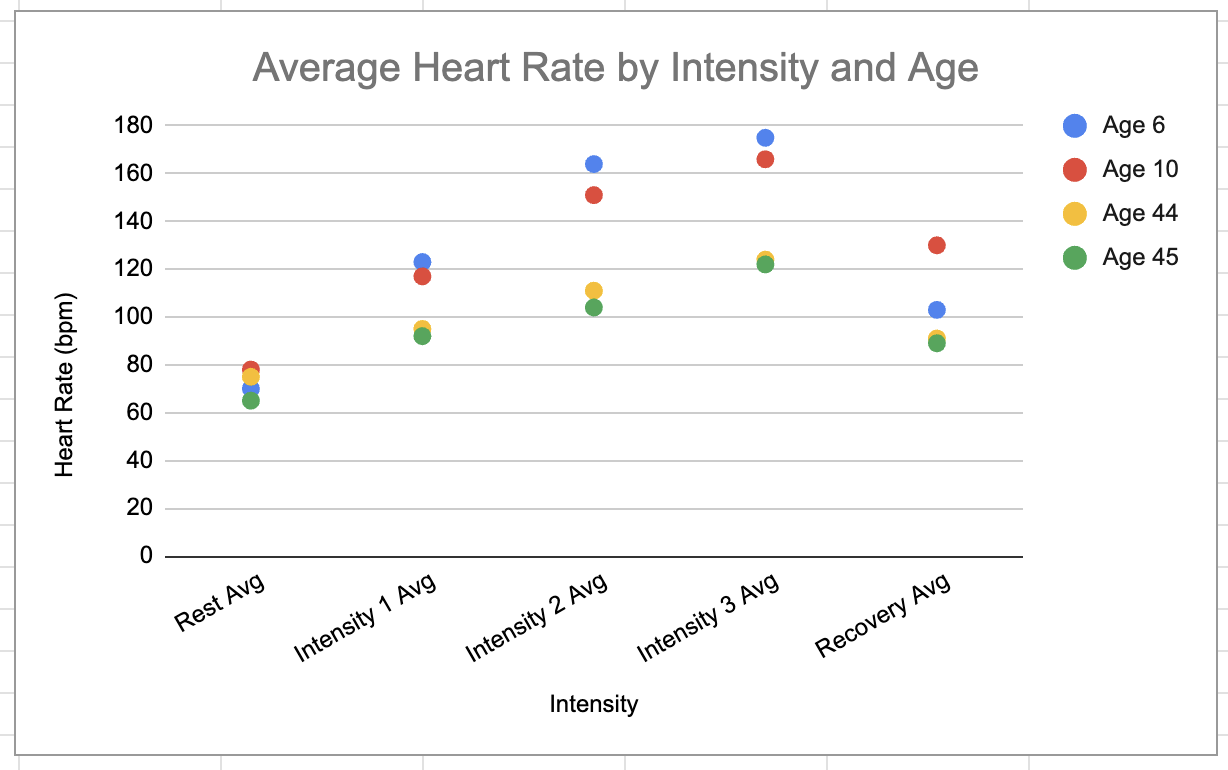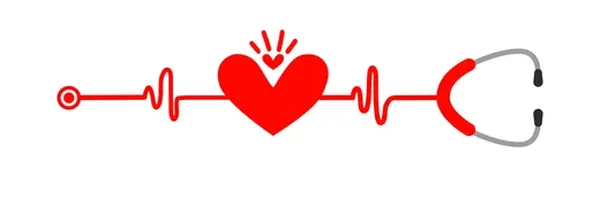Heart rate responses to different intensities of exercise across age groups using wearable devices
Anwyn Lane
Grade 5
Presentation
Hypothesis
Hypothesis 1: Heart rate will increase as exercise intensity increases for all participants
Hypothesis 2: Older people will experience a lower increase in heart rate than younger participants at the same intensities
Research
Imagine your heart is like a superhero. When you're young, it's super speedy and ready to save the day at a moment's notice. But as you get older, it becomes more like a wise old turtle, still strong but taking its time.
So, when younger people do stuff like running or jumping, their hearts speed up quickly to keep up with the action, just like a superhero racing to the rescue. But for older folks, their hearts are more like the turtle—they still speed up, but not as fast. It's because with age, the heart's muscles and nerves might not work as quickly or efficiently as they used to.
So, while both young and old hearts are doing their best, the older heart just takes a bit longer to get up to speed.
Firstly, the muscles in the heart might not be as strong as they once were. It's like if a superhero doesn't train as much, they might not be as strong as before. Also, the blood vessels can become a bit stiffer, making it harder for the blood to flow smoothly. Imagine if the roads the superhero uses to get around become a bit bumpy—it slows them down a bit.
Additionally, the electrical system in the heart, which controls its rhythm, might not work as quickly or as smoothly. It's like if the superhero's communication system starts to glitch a bit—they might not respond as fast.
Variables
Controlled:
- Time of exercise
- Age of participant
- Conditions of the test (temperature, setting)
Manipulated:
- exercise intensity (measured as intensity on the Peloton scale)
Responding:
- Resting heart rate (beats/minute)
- Exercise heart rate (beats/minute)
- Cool Down heart rate (beats/minute)
Procedure
METHODS
Equipment: Peloton Bike, Stethoscope, Apple Watch, computer for data collection, water
Time: Total time for experiment is approximately 30 minutes per participant.
Participants: Up to 10 participants ranging in age from 6-45 years old will participate. All participants will be asked to sign an informed consent and ACSM Pre-Participation Screening Form. In the case of minors, informed consent and screening will be completed by parents. Inclusion criteria: Ages 6-45, male or female, no known health conditions that would make cycling on a Peloton unsafe. Exclusion: <6 or >45. Years of age, known health risks that would make participating in an exercise study unsafe.
Procedure:
Participants will be asked to dress comfortably in exercise clothing and running shoes. They will be asked to sit quietly in a chair for two minutes. We will place the Apple Watch on their right wrist, comfortably. We will then take resting heart rate using both the Apple Watch and stethoscope. All data will be recorded in the Data Sheet (attached). Stethoscope measurements will be taken over the heart. Participants will then be asked to warm up on the Peloton at a light intensity (20) for 3 minutes. Following warm up, they will be asked to cycle for 3 minutes at each of 3 different intensities: light (30), moderate (40) and hard (50). Intensities are defined using the metric on the Peloton bike. At the end of each minute of exercise, we will measure heart rate using both Apple Watch and stethoscope. The highest heart rate achieved at each intensity will be used as the result. Participants will then cool down at a low intensity (20) for 3 minutes. Recovery heart rate will be measured at the end of the cool down.
Supervision: All testing will be supervised by a Professor of Exercise Science, Certified Kinesiologist and Certified Exercise Physiologist (Dr. Christy Lane).
Screening Form: Attached (ACSM Pre-Participation Screening Form)
Informed Consent: Attached
Anonymity: All participants will be provided with an ID number. This will be recorded in the table below and the key available only to the primary researcher.
Observations
General Observations:
1. The heart rate was pretty consistent between the manual meaure and the Apple Watch for all participants.
2. Heart rate increased with intensity for all participants.
3. There was a clear pattern between age and heart rate with exerice. The youngest participant had the highest heart rate at each state, and the oldest had the lowest heart rate.
4. Older people had lower resting and recovery HR than younger people.
|
PARTICIPANT |
1 |
2 |
3 |
4 |
|
Age 10 F |
Age 6 F |
Age 44 M |
Age 45 F |
|
| VARIABLE | ||||
|
Resting HR Manual |
78 |
69 |
74 |
65 |
|
Resting HR Apple |
78 |
70 |
75 |
65 |
|
|
|
|
|
|
|
Intensity 1 (20) |
|
|
|
|
|
Intensity 1 HR Manual Min 1 |
100 |
120 |
90 |
87 |
|
Intensity 1 HR Apple Min 1 |
94 |
116 |
84 |
87 |
|
Intensity 1 HR Manual Min 2 |
115 |
122 |
102 |
90 |
|
Intensity 1 HR Apple Min 2 |
121 |
129 |
91 |
91 |
|
Intensity 1 HR Manual Min 3 |
130 |
128 |
105 |
96 |
|
Intensity 1 HR Apple Min 3 |
141 |
121 |
96 |
97 |
|
|
|
|
|
|
|
Intensity 2 (30) |
||||
|
Intensity 2 HR Manual Min 1 |
145 |
162 |
117 |
105 |
|
Intensity 2 HR Apple Min 1 |
155 |
165 |
106 |
105 |
|
Intensity 2 HR Manual Min 2 |
150 |
160 |
111 |
108 |
|
Intensity 2 HR Apple Min 2 |
156 |
165 |
107 |
104 |
|
Intensity 2 HR Manual Min 3 |
150 |
168 |
115 |
99 |
|
Intensity 2 HR Apple Min 3 |
152 |
165 |
108 |
101 |
|
|
|
|
|
|
|
|
|
|
|
|
|
Intensity 3 (40) |
||||
|
|
|
|
|
|
|
Intensity 3 HR Manual Min 1 |
160 |
189 |
123 |
120 |
|
Intensity 3 HR Apple Min 1 |
162 |
180 |
117 |
118 |
|
Intensity 3 HR Manual Min 2 |
165 |
180 |
130 |
126 |
|
Intensity 3 HR Apple Min 2 |
165 |
167 |
122 |
120 |
|
Intensity 3 HR Manual Min 3 |
170 |
180 |
129 |
126 |
|
Intensity 3 HR Apple Min 3 |
172 |
179 |
123 |
120 |
|
|
|
|
|
|
|
Recovery |
||||
|
Intensity Recovery HR Manual |
126 |
100 |
90 |
90 |
|
Intensity Recovery HR Apple |
133 |
106 |
91 |
87 |
Analysis

Conclusion
Hypothesis 1: Heart rate will incease as exercise intensity increases for all participants
Conclusion 1: We proved this hypothesis. Heart rate increased with intensity for all participants.
Hypothesis 2: Older people will experience a lower increase in heart rate than younger participants at the same intensities
Conclusion 2: We proved this hypothesis. While older people had an increase in HR with exercise, their HR did not increase as much as the younger participants. In fact, the younger the participant, the higher the HR at each intensity.
Application
Underestanding heart rate can be helpful in exercise training at all ages. It is important to understand how a person's heart and heart rate will react to exercise. When training young people, it can be expected that we see a higher heart rate and therefore can plan training according to this. As people age, their heart will not respond the same way, so we need to account for this.
Sources Of Error
- Variations in testing time
- Apple watch not working properly
- Apple watch not fitting properly
- User error, inaccurate counting
- Fatigue or readiness for exercise testing
Citations
https://pubmed.ncbi.nlm.nih.gov/8149532/
https://www.ncbi.nlm.nih.gov/pmc/articles/PMC6306777/
https://www.cdc.gov/physicalactivity/basics/index.htm
https://csepguidelines.ca/guidelines/adults-18-64/
https://www.betterhealth.vic.gov.au/health/healthyliving/exercise-intensity
https://www.ncbi.nlm.nih.gov/pmc/articles/PMC6172294/
https://www.nature.com/articles/s41746-023-00926-4
https://www.mayoclinic.org/healthy-lifestyle/fitness/in-depth/exercise-intensity/art-20046887
Acknowledgement
Thank you to my family for particaplating in the experiment and a special thanks to my parents. My mom is a professor at MRU and specializes in this - she was the one who taught me how to conduct the experiment. Thank you to my dad for printing every thing off and helping me decorate. They were both positive even when I was stressed! Thank you and goodbye.

